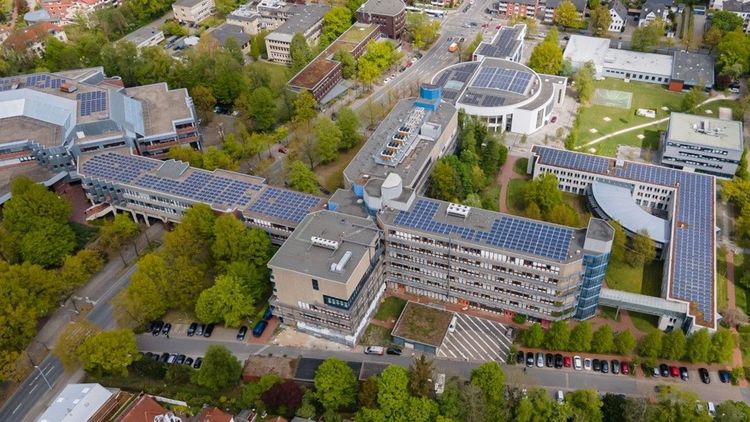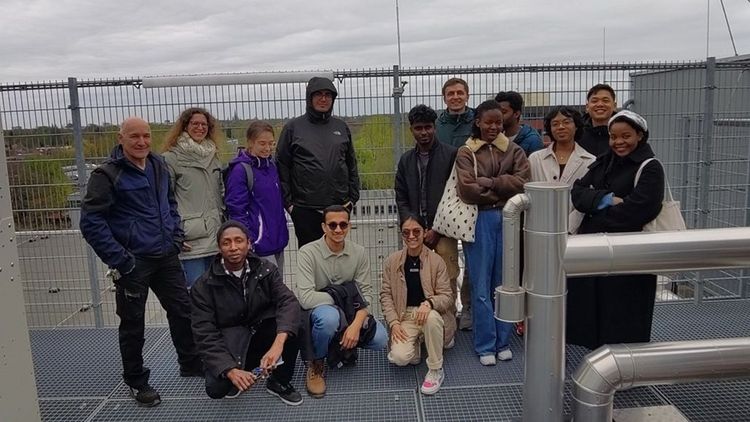A short visit to the University of Oldenburg’s Haarentor Campus’ sustainable energy infrastructure was arranged on 17 April 2025. Particular attention was given to the photovoltaic system in Area A, which, since its commissioning, has covered nearly 80% of usable rooftop space and contributes around 8% to the university’s annual electricity needs. The visit also included insights into innovative systems such as heat recovery from the data centre and a robust backup power setup, offering a well-rounded perspective on how renewable energy can be thoughtfully integrated into a large institutional setting.
- Pradipta Pancham Boruah, India, SuRE 2024 - 2026.
As part of the Sustainable Renewable Energy Technologies (SuRE) and Engineering Physics Masters programs, students participated in an excursion to observe the photovoltaic (PV) system installed in Area A of the University of Oldenburg’s Haarentor Campus. The tour began at the inverter room in Building A14, accessible through a hidden door on the first floor - a fitting start to exploring the university’s impressive infrastructure. The campus is organized into three sections: Areas A, B, and C.
Area A hosts an extensive PV system commissioned in 2022, with approximately 80% of the usable rooftop area covered with solar panels. Full coverage is restricted due to structural limitations on certain buildings. The system generates 4086 MWh of electricity annually, which is sufficient to meet the yearly electricity needs of approximately 120 average households. In comparison, the university’s energy consumption is significant, with 4000 kWh used within a mere three hours. The PV system accounts for approximately 8% of the university’s total annual electricity demand, resulting in considerable financial savings given the institution’s electricity expenditure of nearly 2 million euros per year. As regulations do not permit the external sale of electricity, the university acts as its own consumer. Further details about the system are available here: University of Oldenburg PV Systems.
Area A comprises ten rooftops fitted with approximately 300 solar panels, each rated at 260W. In addition to the PV array, a newly installed heat pump system in building A14 recovers excess heat from the university’s data centre and supplies it to the campus heating network. When surplus heat is not required, it is safely expelled. This installation complies with regulations in Lower Saxony, which require universities to utilize excess heat. The data centre’s cooling needs are supported by a high-performance cluster consisting of six rooftop coolers - three designated for primary operation and three for additional support; as well as a large dedicated cooling room.
The energy infrastructure also includes a transformer station equipped with two 800kW, 20kV transformers and a dedicated generator producing 1 MW of electricity solely for the data centre. The generator operates at ambient temperatures above 40°C, necessitating the use of a heater for startup, and consumes approximately 120 liters of diesel fuel per hour during operation. To ensure reliability, the system undergoes a monthly one-hour test run. Additionally, an emergency backup system provides 400kW of power to maintain essential services such as lighting and fire safety systems during outages.
Additionally, Areas B and C in Campus Wechloy feature photovoltaic systems installed on the rooftops of five individual buildings or building clusters. With a total installed capacity of 168 kWp, these systems generate approximately 139,000 kWh of electricity each year. When assessed against the 2022 federal electricity mix emission factor, this leads to an annual CO₂ savings of up to 60 tons.
The excursion provided valuable insights into the University of Oldenburg´s comprehensive approach to integrating renewable energy and sustainable energy management at an institutional scale.



